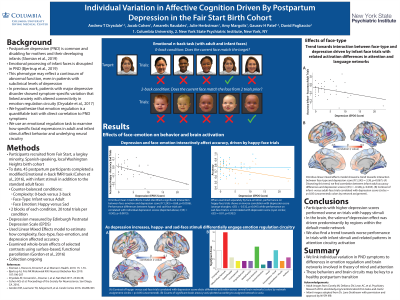Women's Mental Health
Session: Poster Session
(205) Individual Variation in Affective Cognition Driven by Postpartum Depression in the Fair Start Birth Cohort

Trainee Involvement: No

Andrew Drysdale, MD, PhD (he/him/his)
Postdoctoral Research Fellow
Columbia University
New York, New York, United States- JC
Jacob Cohen, Bachelor of Arts
Data Analyst
Columbia University
New York, New York, United States - AR
Amarelis Raudales, BA
Research Assistant
Columbia University Irving Medical Center
New York, New York, United States - JH
Julie Herbstman, PhD
Professor
Columbia University
New York, New York, United States - AM
Amy Margolis, PhD
Associate Professor of Medical Psychology
Columbia University Irving Medical Center
New York, New York, United States - GP
Gaurav H. Patel, n/a
Assistant Professor
Columbia University
New York, New York, United States - DP
David Pagliaccio, PhD
Assistant Professor
New York State Psychiatric Institute
New York, New York, United States
Presenting Author(s)
Co-Author(s)
Background/Significance Perinatal depression (PeriPD) is a common and disabling disorder with extensive societal costs (Slomian, 2019). PeriPD occurs at even higher rates in minority and socioeconomically disadvantaged populations who are often underrepresented in studies of PeriPD’s mechanisms. Emotional processing of infant faces is disrupted in postpartum depression (Bjertrup, 2019). We hypothesize that disruption of this key process is a quantifiable element of postpartum depression. We explore this behavioral phenotype and underlying neural circuitry on an individual basis within the Fair Start birth cohort, which recruits from a largely minority and predominantly Spanish-speaking population. This work represents the first step in developing a methodology for individual characterization of postpartum depression. Methods We have recruited (n=45) postpartum mothers to date for this neuroimaging study, all from Black and/or Latinx background. At 3 months postpartum, participants completed a novel version of an affective cognition Emotional N-Back task (ENBACK, n=40; Cohen, 2016) using adult and infant face stimuli as well as the Edinburgh Postnatal Depression Scale (EPDS). We then compare performance by EPDS score using a linear mixed effects model. All study elements were available in Spanish language on request (n=28). Results A linear mixed effects model of ENBACK accuracy by task condition and depression severity revealed a significant main effect of difficulty (0-back vs. 2-back; F(1,245)=29.60, p< 1*10-6) and a significant interaction between valence (happy vs. sad faces) and EPDS score (F(1,245)=8.68, p< 0.004). Post-hoc comparisons revealed a negative correlation between happy-face, but not sad-face, trial performance and EPDS score (r(35)=-0.33, p< 0.045). Discussion We found that depression selectively impacts performance in a novel ENBACK task utilizing adult and infant stimuli. Depression scores were inversely correlated with performance in trials utilizing happy stimuli. The specificity of these results suggests that postpartum depression impairs processing stimuli of specific valence in a graded fashion. Ongoing neuroimaging analyses will evaluate the neural basis of emotional-n-back performance in this postpartum cohort and their relationship to depression symptoms. Conclusion/Implications: Perinatal depression is linked to dysfunction in emotional regulation. We find impairments in processing positive face stimuli directly proportional to depression severity. Such patient-specific variation may provide a basis for individualized understanding and treatment of perinatal depression. References: Slomien J, et al: Consequences of maternal postpartum depression: A systematic review of maternal and infant outcomes. Women’s Health 2019;15:1-55. Cohen AO, et al: The impact of emotional cues on short-term and long-term memory during adolescence. Proceedings of the Society for Neuroscience. San Diego, CA. 2016.
Bjertrup AJ, et al: The maternal brain: Neural response to infants in mothers with and without mood disorder. Neuroscience and Biobehavioral Reviews 2019;196-207.

